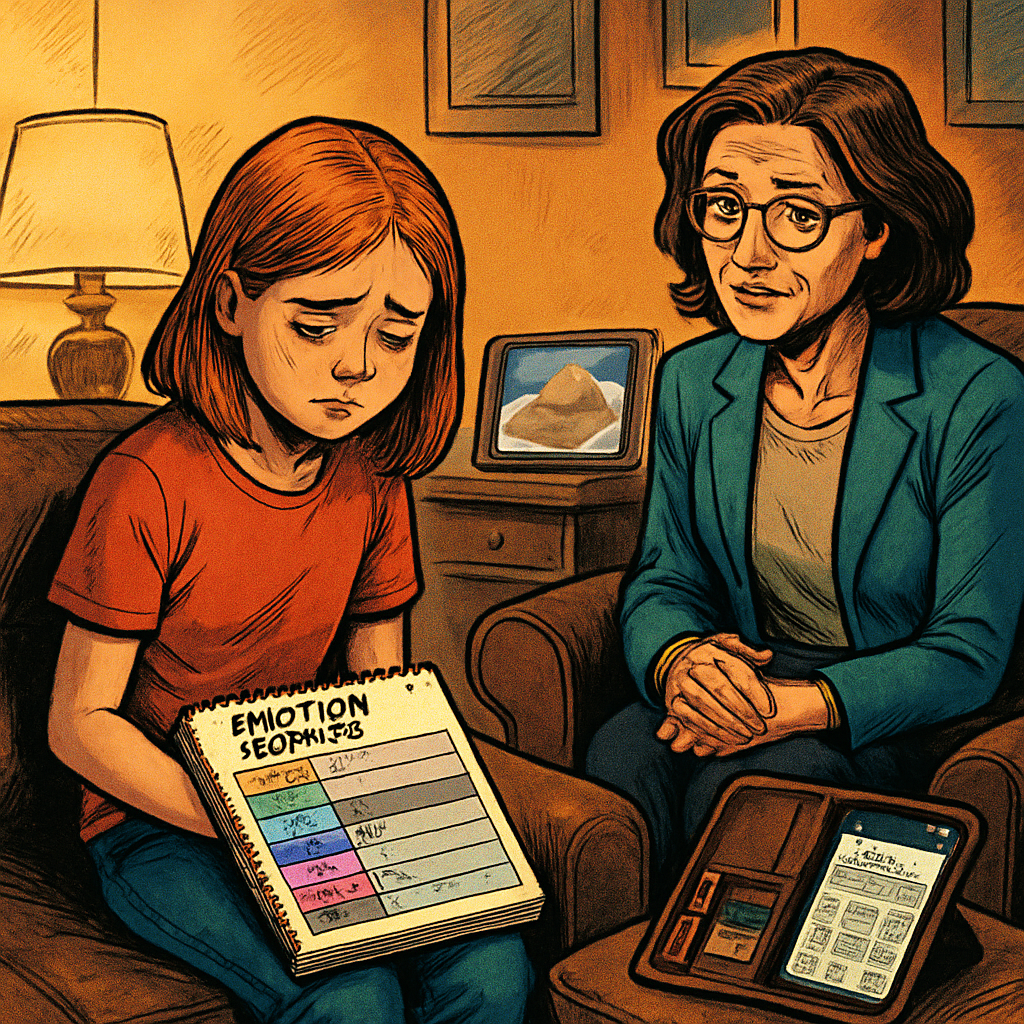Let me put you onto something… I once had a client who’d schedule her sessions right after her corporate job, showing up in pristine business attire with mascara tracks running down her face. She’d sit primly on my office couch, ankles crossed, leather portfolio on her lap, and say with perfect composure: “Sorry about the face leak. Happened in the car. I’m fine. Anyway, how do we make it stop?”
This was Ava. For six months, she’d been sneaking into parking garages to sob between meetings, treating her tears like an embarrassing medical condition she needed to cure. She’d created a complicated system of emergency makeup stations hidden throughout her apartment, car, and office – ready to deploy at the first sign of emotional “weakness.”
I fondly remember Ava for her color-coded emotion journal, where sadness was always highlighted in gray – never blue, because blue was “too pretty for something so useless.” She once confessed she maintained a secret Instagram account dedicated exclusively to videos of people cutting kinetic sand. The oddly satisfying, perfectly clean slices gave her a sense of control when everything else felt chaotic. 300 followers and they never knew their content curator was posting from her bathroom floor at 3 AM.
The Truth About Your War Against Sadness 💀
Did you know 78% of Gen Z reports actively trying to suppress or avoid feelings of sadness? No cap, we’re out here acting like sadness is the emotional equivalent of that one friend who always kills the vibe.
Your Sadness is Actually an Emotional Byte 🧩
That heaviness in your chest isn’t just “being sad” – it’s a complex emotional byte containing:
- Physical sensations (the tightness, the tears)
- Emotional charge (the discomfort)
- Need state information (something you’re missing)
- A mini-narrative about what it means
When you try to delete this emotional byte, you’re actually ignoring crucial data your brain needs to process. It’s like throwing away pieces of a puzzle and then wondering why nothing makes sense.
The Anti-Sadness Scripts Are Failing You 🚩
The moment sadness appears, most of us run the same predictable scripts:
1. The Distraction Script ✨
Immediately reaching for your phone, opening a new tab, or finding ANYTHING to avoid sitting with the feeling
2. The Toxic Positivity Script 🥲
“I shouldn’t feel this way” or “Other people have it worse” or my personal favorite, “good vibes only” (as if emotions respond to manifestation)
3. The Shame Spiral Script 🤌
Where you not only feel sad but then feel bad ABOUT feeling sad, creating a meta-emotional nightmare loop
The truth is, these scripts aren’t protecting you – they’re just creating a backlog of unprocessed emotional bytes that will eventually demand attention, usually at 2 AM on a work night when you’re just trying to watch “comfort food TikToks” in peace.
Signs Your Relationship With Sadness is Actually Healing 🌱
- You’ve stopped treating your tears like they’re the emotional equivalent of a sewage leak
- You notice sadness without immediately reaching for your phone, a drink, or a reason to feel guilty
- You’ve created emotional frames that allow sadness to exist without becoming your entire identity
- Your inner voice has upgraded from “stop being such a baby” to “oh, this is interesting data”
The Granular Truth of the Matter
Reminder: When you validate your sadness, you’re not giving it permission to take over – you’re simply acknowledging that this emotional byte exists for a reason. It’s carrying important information about your needs hierarchy – particularly around connection, meaning, or security.
The TikTok “crying makeup” trend isn’t just aesthetic – it’s a perfect metaphor for what healthy emotional processing looks like. You’re not hiding the fact that you’ve been crying; you’re integrating it into your whole self, making it part of your expression rather than something to be erased.
What Ava eventually discovered (after we worked through her emotional frames) was that her sadness wasn’t a glitch in her emotional operating system – it was a feature. Those “annoying” tears were actually helping her identify which parts of her life weren’t aligned with her deeper values.
Once she started treating sadness as an emotional GPS rather than an enemy, everything shifted. And yes, she still watches kinetic sand videos. But now it’s not an escape – it’s just something that genuinely brings her joy.
—Melanie Doss
💡 Core Insight: If you’re busy fighting your feelings, don’t be shocked when they start fighting back. Sadness doesn’t need a solution – it needs a witness.
P.S. The secret to emotional intelligence isn’t controlling your emotions – it’s developing the kind of relationship with them where they don’t feel the need to scream for your attention.
Additional Resources:
https://pmc.ncbi.nlm.nih.gov/articles/PMC10900636/
https://www.thesupportivecare.com/blog/the-impact-of-grief-on-mental-health-and-how-to-cope
https://pmc.ncbi.nlm.nih.gov/articles/PMC10503261/
https://ourmhm.org/mental-health-tips-how-to-cope-with-grief/
https://www.frontiersin.org/journals/psychiatry/articles/10.3389/fpsyt.2022.1047448/full
https://pmc.ncbi.nlm.nih.gov/articles/PMC7427580/
https://journals.sagepub.com/doi/10.1177/00302228231193806?icid=int.sj-full-text.citing-articles.38

